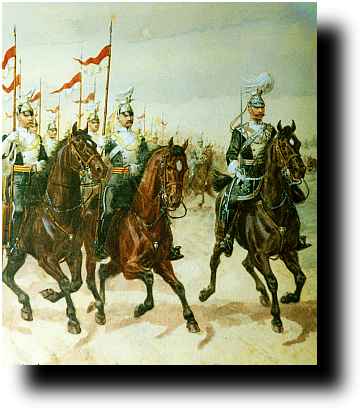|
|

 |
| This painting by Richard Simkin (1851-1926)
gives us an opportunity to compare the uniforms
of officers and other ranks of a period when the
lancer uniform reached it's final form, give or take
a few minor changes. It is interesting to note that
when regiments of today parade in full dress as the bands
do at the Royal Tournament and other occasions, it is in
uniforms almost identical to these that they turn out in.
So this uniform has not changed in over 100 years,
whereas the previous century saw radical changes
every ten years or so. One of the reasons for this
was that this uniform was reserved for ceremonial
occasions more and more, the actual fighting was done
in khaki which was being introduced into the army
in the 1890s. The officer on the right is distinguished by his flouncy white cock feathers attached to his Czapka and his lack of a lance an item never carried by officers. Nevertheless, the stirrups of officers of the 17th had lance buckets attached to them on both sides, the same as the men. The officer's collar is white with gold lace round the top edge and the edge where it fastens in front with hooks and eyes. Senior officers, ie. Major and above had an extra strip of lace on the bottom edge of the collar so that the white was practically obscured. Before 1881 badges of rank were sewn on the collar of the tunic, after that date they were put on the heavily plaited gold cord shoulder straps. On his chest is a full white plastron which replaced the half plastron in 1872. Around his chest, as before are the gold and white pouch belt and the gold cord caplines which attach to the rear of his Czapka. Round his waist, over the tunic is a girdle of three gold lace stripes with red in between. Under his tunic, he wears a webbing belt with five straps suspended from it. Two of these straps which are slimmer versions of the pouch belt, ie. gold with a central white silk stripe, support his sword scabbard, which is silver. The other three straps, slimmer still than the sword slings, support the plain black sabretache, which has a silver 'motto' in the middle. On his legs are boots and breeches, called pantaloons in dress regulations. These have double white cloth stripes down the outside. Boots and breeches replaced the rather ugly leathered overalls in 1872. His charger is wearing a shabraque. It is of dark blue cloth like the uniform with rounded corners and edged with two strips of gold lace, broken bias pattern. on the front corners are Victoria's royal cypher surmounted by a geulphic crown, both embroidered in gold, while the larger rear portions carry the motto on crossed lances, the crown and 17L. On top of the shabraque there was a black sheepskin edged with white felt scallops. The men wear a simplified version of the officer's uniform. The quality of the cloth is courser and is not so well tailored. There is no lace round the white collar and the caplines are yellow wool. The pouch belt is plain white leather with brass buckle, tip and slide which could only be seen from the back, along with the plain black polished leather pouch. This pouch contained 20 rounds for the Martini-Henry Carbine which was carried in a long brown leather holster behind the soldier's right leg. The men carry 9ft long bamboo lances, the bottom point inserted in the stirrup bucket. The red over white pennon was common to all the lancer regiments, red and white being the Polish national colours. |
17th Lancers: Uniforms | Regimental details
Armed Forces | Art and Culture | Articles | Biographies | Colonies | Discussion | Glossary | Home | Library | Links | Map Room | Sources and Media | Science and Technology | Search | Student Zone | Timelines | TV & Film | Wargames